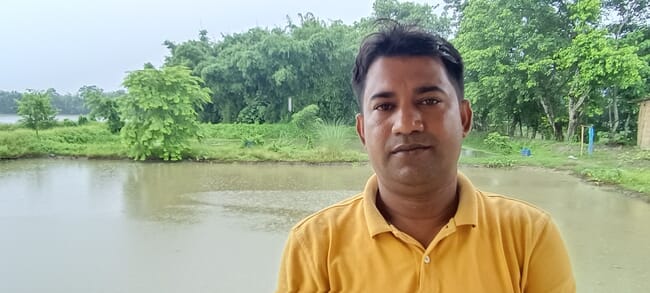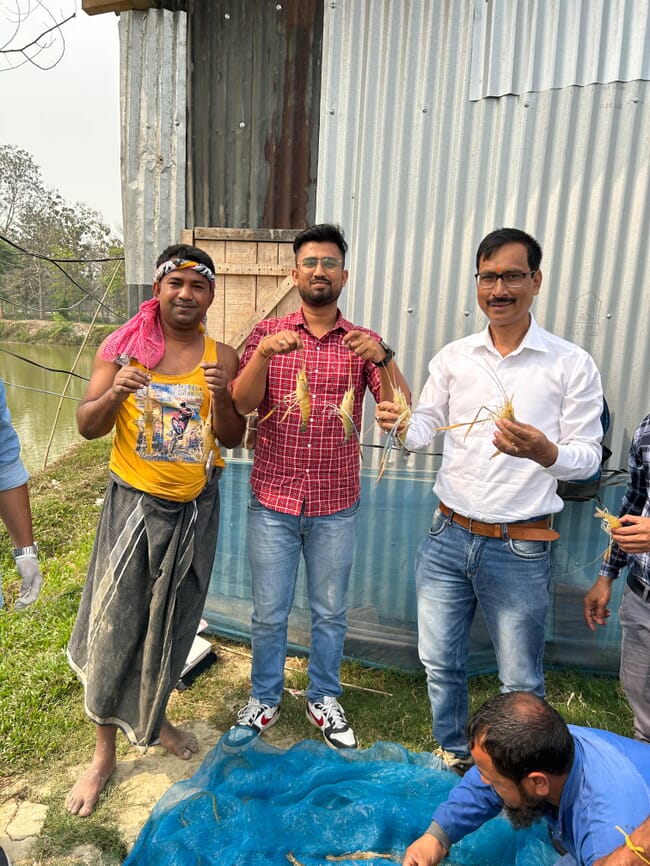
© Gurvinder Singh
Najimuddin Ali has been farming Indian major carp (IMC) in four ponds across four hectares in the Kamrup district of Assam, in northeast India, for the past nine years.
He recently ventured into polyculture, growing genetically improved (GI) giant freshwater prawns (Macrobrachium rosenbergii) alongside his carp and says that he swiftly made a profit of around Rs 50,000 ($600).
“I stocked around 180 common carp along with 2,000 prawns last September. I harvested them in March this year and sold them at a price of around Rs 1200 ($14.37) per kg, making a decent profit. The income is certainly more than what I have been making from fish farming and I have decided to continue with the new variety of prawns,” he explains.

© Gurvinder Singh
Sahjhan Ali tells a similar story.
“I stocked 1,850 prawns along with 200 rohu (Labeo rohita) last September. The mortality rate was around 20 percent but I still managed to make a handsome profit of around Rs 48,000 ($575). I am trying to procure the seeds to continue with prawn farming,” he notes.
The strain of prawns was developed by India’s Central Institute of Freshwater Aquaculture (ICAR-CIFA).
Dr Pratul Barman, the Kamrup district fisheries development officer said that Assam has a huge demand for prawns although the production was only around 26 tonnes in 2023-24, lower than the 41 tonnes in the preceding year.
“The drop in production is due to the non-availability or delay in procuring the seeds from coastal states like Odisha, West Bengal and Andhra Pradesh. The larvae require 11 stages in sea water while the post-larvae can live in fresh water. We tried to develop shrimp in artificial brackish water in Assam but didn’t meet with success,” he explains.
“The prawns have a good demand and we found that GI prawns reached an average size of 80 grams in ten months while the normal strain reaches just 60 grams in the same duration, based on heterogeneous individual growth. The new strain is not only disease-resistant but also has a lower mortality rate. The GI prawns are also ideal for both polyculture and monoculture systems, offering an excellent opportunity for farmers to earn more income,” he adds.

© Assam Fisheries Department
Dr Pratul points out that farming prawns with carp optimises the use of resources, including water, feed and pond space. The integration also diversifies income streams, thereby reducing financial risks for farmers. Prawns and carp occupy different ecological spaces and have distinct feeding habits, offering increased pond productivity through better nutrient cycling, he adds.
Dr Bindu Pillai, principal prawn scientist at ICAR-CIFA, said that the institute developed the CIFA-GI strain in 2021.
“This new strain aims to enhance productivity and profitability in prawn culture. As they were selected for their growth rate, we are not claiming any improvement on disease resistance but on-farm trials revealed good survival of CIFA-GI prawns in most places,” she notes.
She agrees that Assam has good potential for freshwater prawn culture due to the state’s rich water resources.
“The state is the first in northeast India for on-farm trials and the results have been positive. We strongly believe that the strain can add to farmers’ incomes. We have also conducted trials in other states, mostly the coastal belts,” she says.

The prawns are often referred to as scampi in India © Gurvinder Singh
Dr Farhana Hoque, co-lead of the project at ICAR-CIFA, said the size of the selected ponds in Assam varied from 0.15 to 0.25 hectares.
“The stocking density was 10,000 shrimps per hectare and the initial size of stocking was 0.02 grams. The advanced fingerlings of catla and rohu were stocked at a ratio of 20:80, at 6,000 per hectare respectively. The selected farmers were provided with floating fish feed and fish seed for the on-going demonstration programme. Prawns can also be cultured alone, with a stocking density of 30,000 pieces per hectare,” she explains.
“We have selected five hatcheries as multiplier hatcheries for producing CIFA-GI prawn seeds and supplying to the farmers,” she adds.
In 2023, WorldFish India, in collaboration with Assam’s Department of Fisheries, introduced freshwater prawn and carp polyculture under the WorldBank-funded APART project in five districts, Kamrup, Nalbari, Morigaon, Darrang, and Goalpara. The initiative involved the formation of a Farmer Producer Group (FPG) in each selected district.
Each FPG brought together 12-25 farmer members who operated in a five-hectare area.
“The results were remarkable, as the farmers gathered an average production of 60 kg of prawns and 500 kg of fish, driven by high market demand and efficient feeding practices which significantly increased the farmers' incomes,” said a senior government official.




